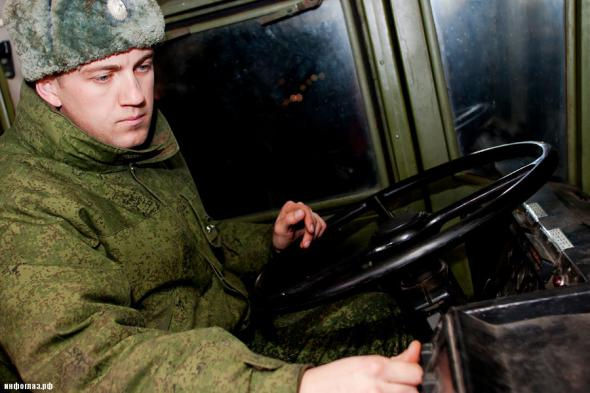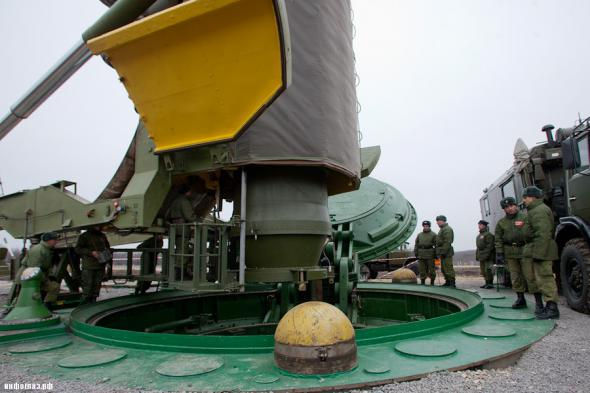
Everyone can be a BOSS!
The RT-2UTTKh «Topol-M» (Russian: PT 2UTTH " Topol-M », NATO reporting name: SS- 27 "Sickle B" , other designations: RS-12M1, RS-12M2, RT-2PM2 ) [4 ] is one of the most recent intercontinental ballistic missiles to be deployed by Russia (see RS- 24 ), and the first to be developed after the dissolution of the Soviet Union.
In its Russian designation RT stands for " solid-fuel missile ," Raketa Tverdotoplivnaya ("solid fuel rocket"), while UTTH - for " improved performance characteristics ," uluchshenniye taktiko-tekhnicheskie kharakteristiki ("improved tactical and technical characteristics"). "Topol" ( poplar ) in Russian means "white poplar". It is designed and produced exclusively by the Moscow Institute of Thermal Technology, and built at the Votkinsk Machine Building Plant

Loading the mine intercontinental ballistic missile " Topol-M "

Transportation and loading into the mine ICBM missile complex 5th generation PT 2PM2 " Topol-M "
PT 2PM2 complex " Topol-M " (code RS-12M2 , according to NATO classification - SS- 27 Sickle « Hammer " ) - Russia's strategic missile complexes with an intercontinental ballistic missile , developed in the late 1980s - early 1990s based on RT-2PM complex "Topol" .
• The first intercontinental ballistic missile , developed in Russia after the Soviet collapse . Entered service in 1997. The head developer of the missile system is the Moscow Institute of Thermal Technology (MIT ) .
Rocket complex " Topol-M " is a solid-fuel , three-stage . Maximum range - 11 000 km . Carries one thermonuclear warhead capacity of 550 kt. Based missile in silos ( silos ) and on mobile launchers . In mine -based version entered service in 2000.
Designed to perform tasks of carrying a nuclear strike on the enemy in the face of opposition existing and future missile defense systems , with multiple nuclear exposure by positioning area , when blocking position area high-altitude nuclear explosions. Applied in the complex 15PO65 silo-based and mobile -based 15P165 .
Stationary complex "Topol-M" includes 10 intercontinental ballistic missiles mounted in silos, as well as a command post.




Key Features:
Number of steps - 3
Length (MS) - 22.55 m
Length (without MS) - 17.5 m
Diameter - 1.81 m
Start weight - 46.5 tons
Throw-weight of 1.2 tons
Fuel type - the blending solid
Maximum Range - 11000 km
Type warhead - monoblock, nuclear, Detachable
Number of warheads - about 20 + 1 dummy
Power Charge - 550 Km
Management system - an autonomous, inertial based ODCC
Way home - mine and mobile



Mobile complex " Topol-M " is a single missile placed in high-strength fiberglass transport and launch container ( TPK ) , mounted on eight- chassis MZKT- 79221 high cross and constructively practically no different from mine option. Weight launcher - 120 tons. Six of the eight pairs of wheels are turning , turning radius that provides 18 meters.
Ground pressure setting two times less than conventional truck. Engine V- shaped 12 -cylinder, turbocharged diesel JAMZ -847 moschnoctyu 800 lc Fording depth up to 1.1 meters.
When creating systems and mobile units " Topol-M " is used a number of innovative technical solutions in comparison with the complex "Topol" . Thus, a system of incomplete hanging allowing deployment of PU " Topol-M " even on soft ground . Improved throughput and flexibility installation , which increases its survivability .
" Topol-M " is able to produce triggers from any position area , and also has improved means of disguise , as against optical and other reconnaissance assets (including by reducing the infrared components unmasking field complex , and the use of special coatings that reduce radar signature ) .
IntercontinentalExchange raketasostoit of three stages with solid boosters . The fuel used is aluminum, acts as an oxidizer ammonium perchlorate . Housing made of composites stages . All three stages are equipped with a rotary nozzle for thrust vector ( trellised aerodynamic control surfaces are absent).




Control system - inertial based on gyro-stabilized platform and ODCC . Complex high command gyroscopic instruments has improved accuracy characteristics . New ODCC has increased productivity and resistance to damaging factors of nuclear explosion. Aiming provided by implementing autonomous azimuth control element mounted on a gyro-stabilized platform , using ground-based command devices placed on the TPK . Provided on high alert , accuracy and continuous operation of onboard equipment .
Method start - mortar for both options . Marching solid rocket motor allows it to pick up speed much faster than previous types of missiles of the same class , created in Russia and the Soviet Union . This greatly complicates its interception of TMD in the active phase of the flight.
The missile is equipped with a detachable warhead with a thermonuclear warhead capacity of 550 kt of TNT . The head part of the complex is also equipped with decoys . Decoys complex consists of passive and active decoys , as well as means of distortion characteristics head. Several dozen auxiliary engines correction , instruments and control mechanisms allow the warhead to maneuver on the trajectory , making it difficult for her to intercept the final trajectory .
Decoys indistinguishable from combat units in all regions of the electromagnetic radiation ( optical, laser , infrared , radar ) . Decoys allow to simulate the characteristics of warheads virtually all featured on a selecting exoatmospheric , transition and much of the atmospheric portion of the descending branch trajectory missile warheads , are resistant to the effects of a nuclear explosion and radiation superpower nuclear-pumped lasers . First designed decoys to withstand radar with superresolution .
In connection with the termination of the existence of START-2 treaty banning the creation of multiply intercontinental ballistic missiles , the Moscow Institute of Thermal Technology is working on framing "Topol -M" MIRV individual guidance . Perhaps the result of this work is the RS-24 " Yars ". Tested the mobile version of this complex, located on eight- chassis tractor MZKT - 79221 .

Highly resistant to the effects of rocket 15ZH65 potential enemy missile defense systems is achieved by :
Reduction in time and length of the active site by extremely rapid acceleration of the rocket. Acceleration time to finite rate (over 7 km / s ) is less than 3 min.
Opportunities rocket maneuver at the active site , complicating decision enemy interception tasks , and also make software maneuver when passing cloud of a nuclear explosion
Protective coating on the new development , which provides comprehensive protection from the damaging effects of nuclear explosions and weapons based on new physical principles.
Complex to overcome missile defense , including passive and active decoys and means distortion characteristics of the head. LC indistinguishable from combat units in all regions of the electromagnetic radiation ( optical, laser , infrared , radar )
allow to simulate the characteristics of warheads virtually all featured on a selecting exoatmospheric , transition and much of the atmospheric portion of the descending branch trajectory missile warheads up to heights 2 - 5 km, are resistant to the effects of a nuclear explosion and radiation superpower nuclear-pumped lasers , etc. First LC designed that can withstand the radar with superresolution . Means distortion characteristics of the head consist of radar absorbing ( combined with heat ) cover MS , generators , etc. jamming radar visibility combat unit has been reduced by several orders of magnitude , the EPR is 0.0001 sq.m. Its detection range reduced to 100 - 200 km. - The optical and infrared visibility BB extremely reduced by the effective cooling surface on the trans-atmospheric section BB and lower luminosity wakes BB on atmospheric plot achieved including by injection in trace area special liquid products that reduce the intensity of radiation . As a result of the measures taken to overcome the monoblock warhead provided mnogoeshelonirovannoy prospective missile defense system with space-based elements with a probability of 0.93 - 0.94 . High-and trans-atmospheric missile site is overcome with a probability of 0.99 , atmospheric - with a probability of 0.93 - 0.95 .




The missile is equipped with 15ZH65 thermonuclear warhead capacity monobloc 0.55 megatons . Tested ICBM MIRV (3 to 6 MIRV capacity of 150 kt. ) Is planned to equip the missile maneuvering warhead ( which tests successfully carried out in 2005 and is ongoing) , in connection with which the interception of MS , according to Russian professionals will be reduced to almost zero.
Circular error probable - no more than 200 meters, which enables MS polumegatonnoy power confidently hit The strong point targets (such as KP and silos ) . Because of the limited throw-weight , limiting power YABCH missile " Topol-M " missile unlike 15A18 " Governor " (power monoblock warhead which was 20-25 MGT ) has restrictions on the implementation of a devastating impact on a large target area .
15P165 complex has unique cell characteristics based initial survival can function autonomously and discreetly for a long period of time. Patrol area of the complex - 250,000 square kilometers
Missile " Topol-M " missile unified with "Bulava" sea-based weapons created for SSBN 955. Competitor " Bulava " is liquid ICBM R - 29RMU2 " The Blue ." It significantly exceeds the " Bulava " ( like all other MDBs) on energomassovomu perfection , but inferior on an important Russian sea-based missiles criterion - survival in the active phase due to the lower rate of acceleration and greater vulnerability to laser weapons , missiles peculiar liquid compared to solid fuel . However, the missile "Bulava" , with a launch weight of about 37 tons, significantly outperformed the striking power of existing heavier solid-fuel missiles , including rocket " Trident " -2 with a launch weight of 59 tonnes. (BC " Bulava " - 6h150 kt, " Trident- 2" (theoretically) - 8h475 kt). Project equipment of the naval component of the nuclear forces with light Russian SSBN ballistic missile "Bulava" criticized specialists , indicating the need for high-tech weaponry Russian SSBN solid- RSM - 39UTTH , tests which have been rolled into the 90s . and which, in the case of putting into service , would have no analogues in the world of SLBMs on striking power and performance specifications.